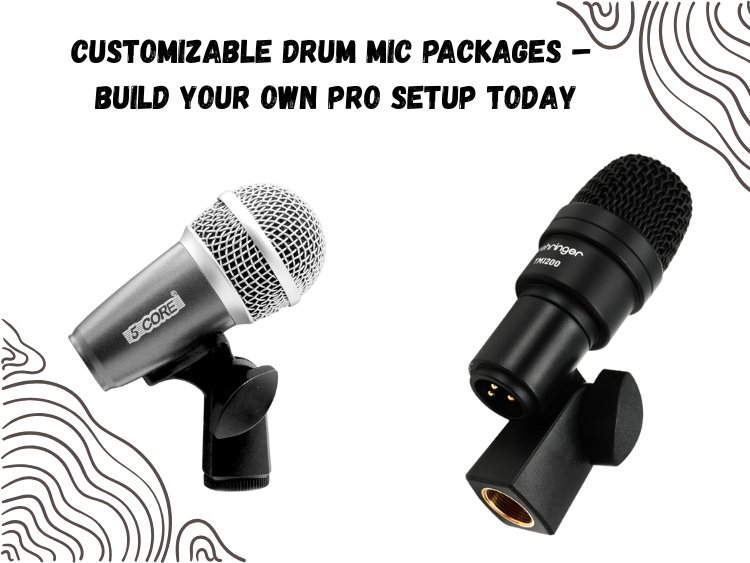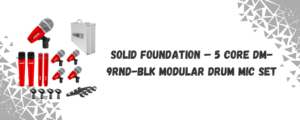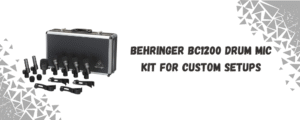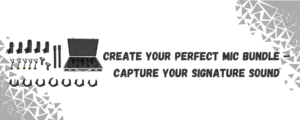One of the biggest mistakes drummers make when investing in microphones? Blindly going for pre-packaged kits without considering what actually works for their kit, their space, or their sound. It’s convenient, sure. But if you’re serious about capturing clean, punchy, and detailed drum recordings—whether live or in the studio—customizing your own mic bundle isn’t just smart. It’s necessary.
Because at the end of the day, your sound isn’t one-size-fits-all. So why should your mic kit be?
Stop Letting the Kit Decide Your Sound
Let’s be real: not every pre-built mic kit is bad. Some of them offer a decent baseline. But the issue lies in control. You get what the manufacturer thinks you need. Not what your specific drum setup, genre, or recording space actually demands.
Some snare mics sound dull on deeper shells. Some kick mics scoop too much midrange, which kills clarity in faster genres. Overheads might be too hyped in the highs for smaller rooms.
This is where custom mic setups shine. You choose what goes where. You build around your tone.
Building Block #1: 5 Core DM-9RND-BLK
The DM-9RND-BLK isn’t just another budget-friendly drum mic kit. It’s one of the few that’s modular enough to act as the base of a customized setup. The dynamic mics are full-metal and tuned with drums in mind—tight transient response, plenty of SPL handling, and minimal coloration.
But here’s the kicker: you don’t have to use all nine mics. Want to swap out the tom mics for your favorite pencil condensers? Do it. Prefer a large-diaphragm condenser for snare? No problem. The DM-9RND-BLK gives you a rock-solid foundation, but it doesn’t lock you in.
Ideal if you want to personalize slowly without starting from scratch.
A Common Jumping-Off Point: Behringer BC1200
If you’ve been around entry-level studios, you’ve seen this kit. The BC1200 is a 7-piece bundle that’s often picked for its price-to-performance ratio. And to be fair, for the money, it covers the basics: kick, snare, toms, and stereo overheads.
But here’s how it fits into a customizable rig—it gives you a baseline. Use the included tom mics to start. Keep the kick mic for rehearsal tracking. But when it’s time to record something serious? Upgrade just the snare mic. Or drop the overheads and run a stereo ribbon pair instead. You’re not tied to anything. The BC1200 is a scaffolding kit—nothing more, nothing less.
Where Most People Get It Wrong
Personalizing your mic kit sounds great on paper, but a lot of people jump in without a plan. And they end up overspending or buying mics that don’t complement each other. Avoid that mess. Start with this:
- Snare and kick first. These two mics shape 80% of your drum sound. If they sound right, the rest falls into place.
- Build out from there. Add tom mics only if you’re close-miking. Otherwise, let overheads do the lifting.
- Choose overheads based on your room. Small, reflective rooms need tight patterns and smooth top-end. Big rooms? You can go brighter and wider.
- Always leave space for growth. Buying a mic you’ll “just upgrade later” is usually a waste. Get the right tool the first time.
Sweetwater’s Modular Approach
Sweetwater isn’t just selling fixed kits anymore. A lot of their bundles are flexible at checkout. You can build a cart with your preferred snare mic, a favorite kick mic (like the D112 or Beta 52), then tack on overheads that make sense for your room. They’ll often recommend what plays well together if you ask.
This gives you a semi-custom solution without needing to source mics from five different stores. It’s worth noting for anyone who wants control and convenience.
Final Thoughts: Don’t Buy the Wrong Kit Just Because It’s “Complete”
A full mic kit with eight or nine mics looks impressive on paper. But the truth? Half of those mics might not even make it into your final mix.
That’s why building your own personalized drum mic bundle isn’t just a luxury—it’s the smarter move. Start with a foundation like the 5 Core DM-9RND-BLK, expand carefully based on your setup, and tweak along the way.
Because at the end of the day, this isn’t about collecting gear. It’s about capturing a sound that’s yours—and only yours.




